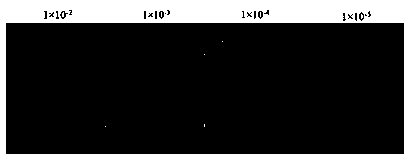Single-domain antibody aiming at apolipoprotein A1 and application thereof
A technology of apolipoprotein and single-domain antibody, which is applied in the field of biomedicine or biopharmaceuticals, and can solve problems such as low sensitivity, poor antibody stability, and limited detection of apolipoprotein A1
- Summary
- Abstract
- Description
- Claims
- Application Information
AI Technical Summary
Problems solved by technology
Method used
Image
Examples
Embodiment 1
[0026] Example 1: Construction of a single domain antibody library against apolipoprotein A1:
[0027] (1) Apolipoprotein A1 extracted from human blood (purchased from Nanjing Huibiao Biotechnology Co., Ltd.), the concentration of apolipoprotein A1 used for immunization was 500 μg / mL, and 0.5 mg of apolipoprotein A1 was added to each immunization Mix with Freund's adjuvant in equal volume, immunize a Xinjiang dromedary (Jurong Shenglong Livestock Breeding Factory), once a week, and immunize 5 times in total, except for the first use of complete Freund's adjuvant (purchased from sigma ), Freund's incomplete adjuvant (purchased from sigma) was used for the remaining times to stimulate B cells to express antigen-specific single domain antibodies during the immunization process. (2) After the 5 times of immunization, extract 100 mL of camel peripheral blood lymphocytes and extract total RNA referring to the RNA extraction kit provided by QIAGEN. (3) According to the Super-Script ...
Embodiment 2
[0037] Example 2: Screening process for single domain antibodies against apolipoprotein A1:
[0038] (1) Coat 100 μg / mL apolipoprotein A1 dissolved in PBS on a NUNC plate and place it at 4°C overnight, and set up a negative control at the same time. (2) On the second day, add 200 μL of 1% milk to the two wells respectively, and block at room temperature for 2 hours. (3) After 2 hours, add 100 μL of phage (8×10 11 tfu immunized camel single-domain antibody phage display gene library) for 1 hour at room temperature. (4) Wash 5 times with PBST (0.05% Tween 20 in PBS) to wash away unbound phages. (5) Use triethylamine (100mM) to dissociate the phage that specifically binds to apolipoprotein A1, and infect Escherichia coli TG1 in logarithmic phase growth, produce and purify the phage for the next round of screening, The same screening process was repeated for 2 rounds. The result is as Figure 4 Display: In the process of continuous screening, positive clones will be continuou...
Embodiment 3
[0039] Example 3: Using phage enzyme-linked immunosorbent method (ELISA) to screen specific single positive clones:
[0040] The schematic diagram of the experiment is shown in Figure 5 As shown, the specific detection is as follows:
[0041] (1) From the cell culture dish containing phage after 3-4 rounds of selection, pick 96 single colonies and inoculate them in TB medium containing 100 μg / mL ampicillin (1 LTB medium contains 2.3 g potassium dihydrogen phosphate, 12.52g dipotassium hydrogen phosphate, 12g peptone, 24g yeast extract, 4mL glycerol), grow to the log phase, add IPTG with a final concentration of 1mmol, and culture overnight at 28°C. (2) Use the infiltration method to obtain the crudely extracted antibody, and transfer the antibody to an antigen-coated ELISA plate, and place it at room temperature for 1 hour. (3) Wash off unbound antibodies with PBST, add primary mouse anti-HA tag antibody (anti-mouse anti-HA antibody, purchased from Beijing Kangwei Century B...
PUM
 Login to View More
Login to View More Abstract
Description
Claims
Application Information
 Login to View More
Login to View More - R&D
- Intellectual Property
- Life Sciences
- Materials
- Tech Scout
- Unparalleled Data Quality
- Higher Quality Content
- 60% Fewer Hallucinations
Browse by: Latest US Patents, China's latest patents, Technical Efficacy Thesaurus, Application Domain, Technology Topic, Popular Technical Reports.
© 2025 PatSnap. All rights reserved.Legal|Privacy policy|Modern Slavery Act Transparency Statement|Sitemap|About US| Contact US: help@patsnap.com



